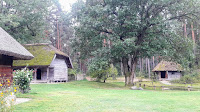Hi, Everyone. As you can see, it's been ages since I last wrote in my blog. In fact, I wrote just as the coronavirus was beginning, and I was on my way home from my trip through Eastern Europe. I'm so glad I took that wonderful trip because while we were locked down and unable to travel, I could think back and remember the wonderful sights I'd seen in Budapest, Lithuania, Latvia, Estonia, Helsinki and St. Petersburg. Really, travel to me is my lifeblood. Without it, I feel I'm not living life to the full.
On my way home from my trip, I had a long distance flight from St. Petersburg to Hong Kong, and then took a busy train into the city, and was therefore exposed to a lot of people for a long period of time. Although we didn't realise it at that stage, coronavirus had already begun, and I think I was mildly infected on my trip back to Australia because when I got home, I developed a very strange cold, with no runny nose, but a very nasty feeling deep down in the bottom of my lungs. It felt different from any feeling I had experienced with a cold before. I also felt incredibly tired. However, luckily, because I am a strong person, after three days, that nasty feeling in my lungs went away, as my immune system fought off the virus, whatever it was.
Now that we know what the symptoms of coronavirus are, and especially the original strain which went right down inside people's lungs (either the Wuhan or Alpha strain), I think that that's what I caught! Luckily, it looks as though I only caught a small viral load, and that's why I coped quite well. Anyway, while everyone else around me has suffered from coronavirus at some stage over the past three years, I have remained healthy. I think that possible early infection made me resistant to any further variants that came along.
Since I last wrote, my youngest son, Jack, encouraged me to start a new hobby. He said, "Mum, why don't you start a podcast." I asked him how I should do that, and he told me that there was an easy-to-use app called "Anchor" that could help make podcasts easily. Then I said to him, "What on Earth should I talk about?" and he said that I would be sure to think of something.
Well, it's been a year since I installed the Anchor app, and I've just finished making my fortieth podcast. Every time I finish a podcast talk, I think that it will be the very last because there couldn't possibly be anything else for me to talk about. Sometimes an idea will come into my head, but I don't know if or when I'll do another podcast. Just in case you are interested, whichever podcast app you have on your phone or computer, you will find me at "This, That and the Other" Kathi Wyldeck. The podcast includes fiction stories that I've made up, recounts of my own real-life experiences, science topics I'm interested in, and a few of my opinions about the world. You might enjoy some of my talks.
I am in the process of making a book of podcast transcripts so that I have a record of the topics I've spoken about, and also for anyone who may be interested in reading what I've said. Some of my scientific podcast topics are very detailed, so being able to read and think about these subjects in more detail would help the ideas sink in bit more thoroughly. The book will be available at Lulu.com and on Amazon when I've finished writing it.
Before the coronavirus began, I created a blog book too, as I didn't want to lose everything I'd put into making this series of blogs over about a fifteen-year period. Just in case some catastrophe happens to the Internet in the future, at least I will have saved my efforts as "Kathi's Blog Book", and soon also as "This, That and the Other" for my podcast book. Well that's it for now. All the best and see you next time.























































































































































































































